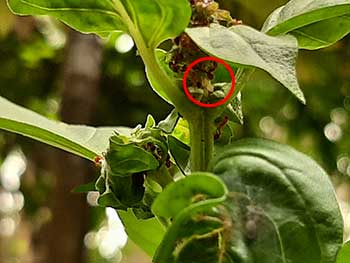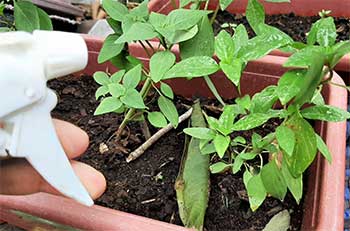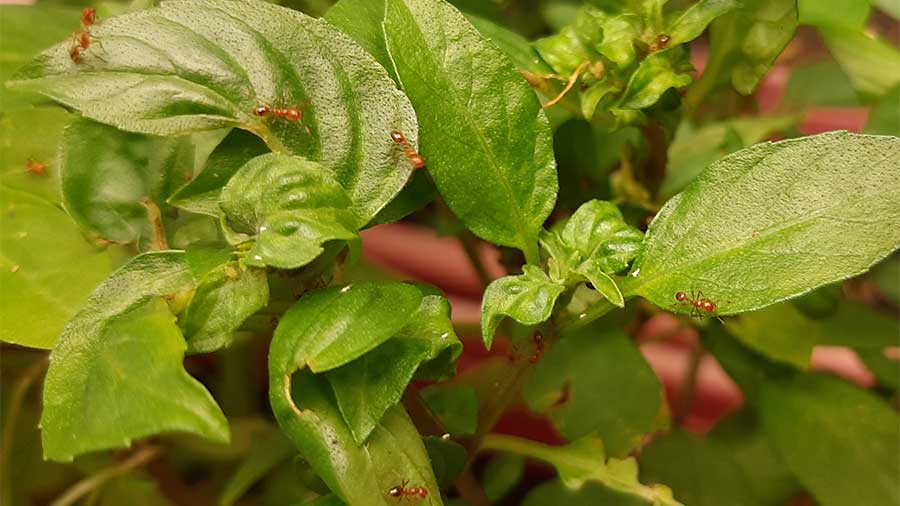It has been a month since I first picked off several leaves of my basil plants for cooking. Now, when I tried to harvest a new batch of leaves, I felt a sting in my fingers. It was then that I saw the little bugs that were hiding in the leaves. The ants were reddish in color and they seem to form groups on top of new foliage growth.
I noticed that the new leaf growth was curled up and I think that the ants have something to do with it. I did some research and found my answer. The ants in the basil plant are working with aphids by carrying them to the soft tissues of new leaf growth. Aphids are soft-bodied insects that suck the moisture and nutrients off the leaves. In return, the aphids secrete a sweet liquid that becomes food for the ants. To get rid of the ants, you need to get rid of the aphids. A spray of pesticides is needed to kill the aphids. A good organic pesticide can be made from a mixture of garlic, mineral oil, and liquid soap. To get rid of ants, you may apply a concoction of borax, sugar, and water.

Why Are There Ants in My Garden?
Ants are almost everywhere. They are commonly found on the ground. They like to build their homes in loose, damp soil. Some ants like to eat the sweet sap from plants and fruits. Others prefer decaying proteins from organic matter. While some like to forage on seeds.
Generally, ants do not harm your plants. They are useful when they are just on the ground. When they dig tiny tunnels underground, they are helping aerate the soil. The plants’ roots also breathe air. When the roots are waterlogged, the roots can actually drown.
In this condition, they can no longer take in the nutrients from the soil. The tunnels made by ants help to let the water evaporate. Their constant movement underground also helps in loosening the soil so water drains easily. This is important especially if you are planting in pots or containers.
The problem starts when these ants start climbing up your plants. You may think that they are eating away the leaves, but in my experience, they are doing something else. I have observed that although they gather in numbers on new leaf growth, they are not eating it.
Instead, what they do is they carry a type of harmful insect on the new growth. These insects, called aphids, are light green or yellowish in color, depending on the species. They feed on the soft tissues of the new leaves. They are very tiny, about 1/8th of an inch. Once the aphids are in place, they suck at the moisture along with the nutrients from the soft leaves. And since basil is an herbaceous plant, the aphids have plenty of food to eat.

In return, the aphids secrete sweet nectar from their body which will serve as food for the ants. The ants will then gather around the aphids, not just to harvest food, but also to protect the aphids. That is why you see these ants gathering on the leaves. That is also why I got stung by these ants when I picked off some of the leaves.
The First Step is to Get Rid of Aphids
The quickest way to get rid of aphids is to make an organic pesticide from materials readily available in your kitchen. You can also buy commercially-available pesticides if you can wait. It is important to kill the aphids because if left untreated, your plants will wither and die. Here are some of my homemade organic pesticide recipes.
Garlic Repellant Spray
2 bulbs garlic
1 liter water
½ cup mineral or vegetable oil *if not available, you may use any cooking oil
1 tablespoon liquid soap
Chop the garlic into small pieces. Using a blender, mix the garlic in 1 liter of water. Let the mixture sit overnight. Afterward, remove the solid particles. I use a clean strainer to separate the liquid. Next, add in the vegetable oil and the liquid soap. Mix thoroughly.
To use, dilute the mixture in water. The dilution rate is 500 ml/liter of water. Spray once to twice a week. You can use the mixture for up to a month. Just keep it in a cool, dry area away from direct sunlight. Make sure to cover it tightly.
Cayenne (Chili) Pepper Spray
100 grams of finely chopped hot pepper (or about 10 pieces cayenne)
1 liter of water
1 tablespoon liquid dishwashing soap
In a container, combine the chopped pepper, liquid soap, and water. Gently stir the mixture. Let the mixture steep for about 24 hours. To use, remove the solid particles by using a strainer. Pour the liquid into a spray applicator and use it as a foliage spray. Apply once or twice a week. If you don’t have access to cayenne pepper, you may use Tabasco.
Chili Garlic Spray
2 bulbs garlic
1 bulb onion
100 grams chili (or cayenne pepper)
1 tablespoon liquid dishwashing soap
1 liter water
Blend the chili, garlic, and onion in 1 liter of water. Strain the mixture to remove solid particles. Add the liquid soap. Mix thoroughly. There’s no need to dilute this mixture, you can spray this immediately. Use on leafy plants only. Insects tend to avoid the smell of garlic, even the good ones, so don’t apply on flowering plants. Apply once or twice a week.

Again, if you don’t have cayenne pepper or any chili variety at home, you may use Tabasco.
Oil and Soap Spray
This is by far the most effective method in getting rid of aphids in my basil plants. I made an experiment wherein I tried to observe the effects of four homemade pesticides on my basil plants. You can read about my own experiment here: The Best Homemade Pesticide Every Gardener Should Know
The procedure in making the oil and soap spray is straightforward. You just have to mix about 1 cup of vegetable oil (any common cooking oil will do) with 1 tablespoon of dishwashing soap. To apply, dilute first in water. The ratio is 10 ml per liter of water.
How to Get Rid of Ants
Once you have eliminated the aphids, you can start getting rid of the ants. Again, there are commercially available ant repellants available. Some are even organic. But if you can’t wait, or you just want to make a do-it-yourself repellant, here are some of my methods.
Borax
1 tbsp borax and 1 tbsp white sugar.
2 tbsp water
Borax is used for cleaning purposes. Mix everything until you produce a paste-like texture. Pour this mixture in the soil, or around your containers. For fast results, look for the ant’s nest and place it there. The sugar attracts the ants while the borax acts like a poison. They will bring it to their nest and store it for food. Apply by putting directly in the soil using a spoon.
Baking soda
1 tbsp baking soda
1 tbsp sugar
2 tbsp Cooking Oil
If you like baking, then you may have some extra baking soda in your kitchen. Baking soda has sodium bicarbonate which acts as an insecticide. Mix baking soda and sugar. Add oil until it has a paste-like texture. Apply by putting directly in the soil using a spoon.
Petroleum Jelly
Ants become a problem if they climb into the plant. To prevent them from climbing, apply petroleum jelly to the base of the plant. It does not dry out in the sun or wash away in the rain. This is a neat hack for petroleum jelly. It’s simple, yet effective. It doesn’t kill the ants but it sure does stop them from climbing it.
Mouthwash
1 cap mouthwash
500 ml water
The common mouthwash has thymol, which is an active ingredient in pesticide products. To use, just mix the mouthwash with water and apply it as a spray. Do not spray directly on the leaves. Spray on the ground or around the pot. The effect should be instantaneous.
For other ways to get rid of bugs naturally, you may read this article.
Benefits of Pest-Free Basil
Basil is prized for its aromatic flavor and minty taste. It is commonly used in pasta dishes. It is also used as pesto, or mixed with tomatoes. Because of this, you need to ensure that the basil leaves are clean and free of chemical pesticides. Organic pesticides have short residual action. Meaning they don’t stick with the plant for long. Unlike chemical pesticides, which can stay in the leaves long after it is applied.










